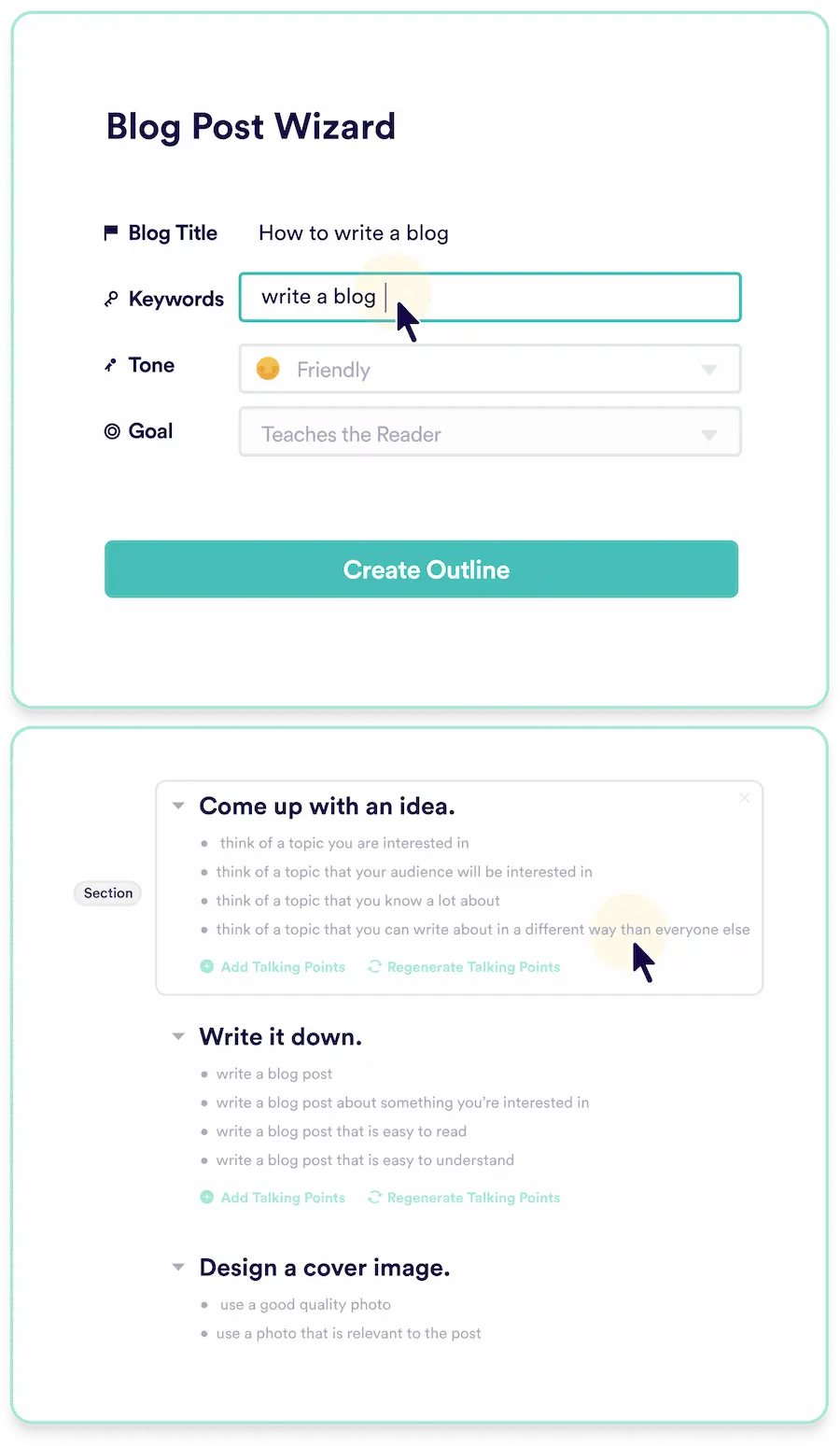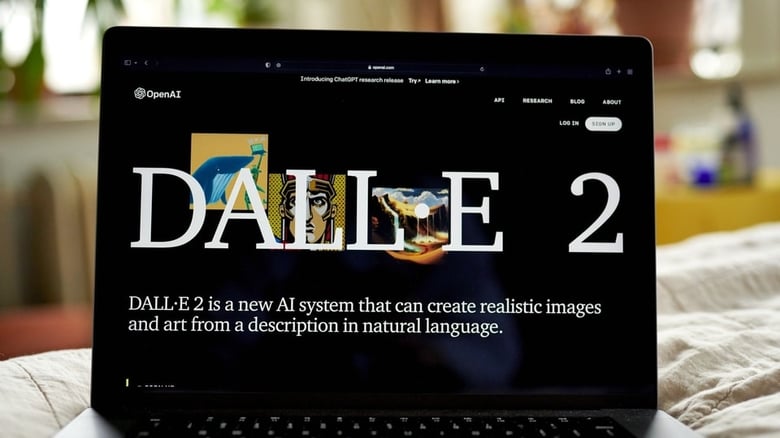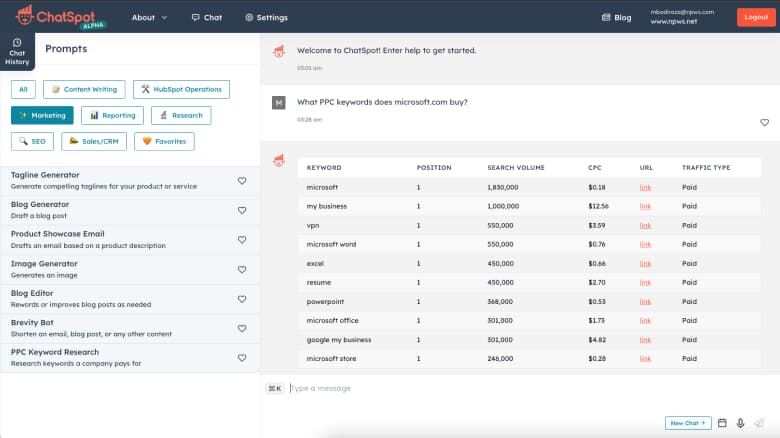Leveraging AI for B2B Content Marketing Success

AI has taken B2B marketing by storm. A recent survey by Forrester found that AI is being used by marketers in 67% of B2B organizations, with over 70% planning to increase their plans for using AI in their marketing processes.
With the field seemingly moving at lightning speed and new marketing tools and AI tools popping up every day, it can be overwhelming for B2B content marketers to know how to leverage AI for immediate impact right now. The good news: once you know how AI can boost your content lifecycle, bringing AI into your content strategy is a matter of four key steps.
In this article, we take a look at how B2B content marketers can apply current AI tools to help with everything from competitor research, to content strategy and planning, to content creation and campaign execution, to optimization and governance.
We’ll explore not only how you can use generative artificial intelligence to speed things up on the content production side, but also some other types of AI-powered platforms to inform your overall content plan.
Generative AI in B2B content marketing
Thanks to the success of ChatGPT, generative AI tools have been receiving most of the attention in the current AI hype. Generative AI refers to a broad range AI systems or algorithms, such as ChatGPT, that can be used to generate new outputs based on the training data, and that users interact with using natural language prompts.
Generative AI tools are the easiest place for B2B content marketers to start using AI tools to increase productivity, as they can make creating a whole range of documents and other content outputs much easier.
According to a survey by Botco.AI, 73% of marketing executives say their companies are already using generative AI to help create content, and 31% of non-users say they expect to do so within a year.
However, generative AI models, particularly large language models (LLMs) like ChatGPT, are not the only type of AI that B2B content marketers can tap into to supercharge their workflows.
AI is a very broad field, and there are a number of platforms using other types of machine learning models that can synthesize useful insights from vast amounts of data.
Step 1: Use generative AI for competitive intelligence and market research
Before devising your content strategy, your marketing team is likely going to do some competitive research, devise your brand positioning in the marketplace, and define your target audience. Depending on the size of your particular B2B company, AI tools can help in a number of ways.
Use generative AI for market research and buyer personas
For smaller marketing teams, using a generative AI tool such as ChatGPT can aid the research process you would do manually. In addition to searching the web and gathering findings, dialoguing with ChatGPT can provide answers instantly. However, always be sure to double-check its findings, as it can ‘hallucinate’ or make up information.
To get the best results from generative AI tools, provide as much structure and clarity as possible in your prompts. This is where any pre-existing processes and documents can help. A good example is your buyer personas. Using the template you already have, ask ChatGPT to construct buyer personas based on needs, goals, intent, and behavior.
Using AI in this way accelerates your processes and allows you to scale and iterate that much quicker, but it does not replace them entirely. You still need to know your target market, but you can now do research and develop your guiding documents much more quickly.
Market intelligence and AI-powered intent data for B2B companies
For larger B2B organizations or those with more competitive, high-ticket sales processes, there are AI-powered tools (beyond generative AI) that utilize machine learning to analyze online data and surface strategic insights to your marketing and sales teams.
Crayon is a competitive intelligence platform that helps you track your competitors in real time. Going well beyond the battlecard you made two years ago and haven’t updated since,
Crayon taps into over a hundred different types across millions of sources to deliver CI reports with information such as product updates, messaging pivots, executive team changes, and more.
As a content marketer, you can analyze your competitor's content and social media output to discover their core topics, differentiate your content strategy, and ensure you’re competing for attention on all the same channels.
The platform has battlecards and other sales tools as well, except they’re created dynamically, based on the latest data. Look into Klue for another option with similar functionality.
If your company has an Account-Based Marketing strategy, an AI-powered tool such as 6Sense may help. 6sense is a B2B marketing platform that uses AI and machine learning to help businesses identify and target potential customers.
The software orchestrates data from millions of potential buyers to map decision-maker behavior and uncover intent that falls outside traditional inbound marketing funnels, in what 6sense labels the “Dark Funnel,” or anonymous online research by B2B buyers. Using the tool, marketing teams can gauge buying intent levels at target company accounts, and craft targeted messages to push these accounts further down the funnel.
Step 2: AI-driven SEO, generative AI search, and topic research
Use an AI-powered content intelligence tool for topic planning and content optimization
Numerous AI-powered tools can analyze your content performance data and website domain, compare it to other websites, and offer suggestions on what topics to write about. These systems are usually called content intelligence platforms, and there are a variety of product offerings with varying features.
At a high level, content intelligence software uses AI and data analytics to help marketers optimize their content for better engagement, performance, and ROI, providing insights into how content is performing across different channels and helping to identify opportunities for improvement.
These tools typically include features such as content analytics, content optimization, audience analysis, and content discovery.
Tools such as MarketMuse or Surfer SEO can help smaller or lone B2B content marketers audit your existing content and develop a complete, data-based organic content strategy aimed at developing topical authority — a key factor in ranking in search engine results.
Discover new keywords for blog posts using generative AI
If you don’t have the budget, need, or expertise to use a content intelligence platform, you can use a tool such as ChatGPT to brainstorm keywords and topics related to your business to target on your blog. You can even ask ChatGPT to place the keywords into clusters of related keywords, so you can target more than one in a single article.
However, be careful about relying on ChatGPT for your keyword research — you’re better off using an established keyword research tool on a platform such as Ahrefs or SEMRush, so your SEO lead can use their proprietary data to evaluate keyword search volume and competitiveness, and prioritize those that make the most sense for your website at the time.
Quickly create content briefs and outlines for your writers
The final step for a content strategist is to create a content brief and perhaps even an outline for your content writer. This is a step where generative AI shines. Use your favorite generative AI tools such as ChatGPT, copy.ai (our favorite), Jasper, or even HubSpot’s new ChatSpot to take the topics and keywords you’ve developed in the previous step and create full outlines and content briefs.
 Source: Copy.ai / Image showing how easy the process can be with a tool as powerful as copy.ai
Source: Copy.ai / Image showing how easy the process can be with a tool as powerful as copy.ai
First, take your topic list and use the AI tool to brainstorm different ideas, angles, and titles. Keep playing with it until you find one you like — trust your human judgment here on what makes a compelling angle to differentiate your content from the rest at the top of the SERPs.
Then, ask the tool to imagine it is a content strategist and create an outline for an SEO-optimized article with your chosen title. The more specific you are with your prompt, the better results you will get. Ask it to include your chosen keywords and any other information you want in the article.
If you’re unhappy with the result, ask it to try again; there’s no reason to accept its first output if you’re unsatisfied. Once you have an outline that is up to your standards, ask it to generate a content brief (again, feel free to feed it the structure of the brief you currently use; the more structure, the better).
Now, you should have a content brief and outline, complete with keywords, that you can pass on to your writer.
Step 3: AI-assited content creation
Now we’ve gotten to the good part: actually creating content. You’ve done your AI-assisted research, created a content strategy, and now you want the robots to deliver that ever-present commodity: brand content!
In the wake of the success of ChatGPT, most of the attention of generative AI tools has gone to its ability to create text-based content, such as blog posts, emails, ads, social posts, or anything else you can cram words into.
Since written content is such an important area to experiment with when it comes to generative AI, we’ve written a whole separate post covering how AI text generation works and how to use it for your marketing content.
We recommend you check it out. But we’re not done yet: generative AI is not only used to generate text or for your blog posts. It can be used to generate images and videos as well. Partly-automated multi-channel content strategy, here we come!
AI image genaration
AI image generators take a text prompt and attempt to turn it into a matching image. As the prompt can be anything you can imagine, enthusiasts have used these tools to create some wild images, from twists on classic artworks to animals partaking in human activities.
However, AI image generation tools can create more than internet novelty art, such as helping you create new, creative images to replace hours scouring stock image sites only to choose the same generic pictures as your competitors.
Like other generative AI tools, most AI image generators use the same few core models to create their outputs. So don’t worry too much about which one is ‘best,’ rather, find the one that fits with your current workflows and budget.
Here are a few AI image generation tools to try out:
DALL-E is an AI-powered image generation tool developed by OpenAI (the same organization behind ChatGPT) that uses natural language processing and generative models to create unique images from textual input. The release of DALL-E in 2021 was the first AI image generation model released to the public.

You’re probably familiar with Canva, as it has become one of the most popular tools for creating visuals of all types, from social media posts to print designs to videos. Canva now has an AI image generator built-in, allowing you to create images from text, choose from pre-set styles, and then edit in its familiar interface.
Jasper, one of the leading solutions for generative AI text creation, also has an art generator that converts text to images.
A competitor to Jasper, Writesonic is another popular generative AI writing tool, with Photosonic as its text-to-image feature.
If you have more sophisticated image generation needs, NightCafe incorporates a broader range of AI image algorithms, including Stable Diffusion, DALL-E 2, CLIP-Guided Diffusion, VQGAN+CLIP and Neural Style Transfer, giving you greater flexibility.
AI video generation: The glimpse of future that's already here
Generating images from text is one thing… but entire videos? With just a text input, you can now create a product or training video in minutes, complete with an AI avatar reading the script. The quality of these videos is a lot better than you might expect, and getting better all the time.
That said, some people may find the AI avatars a little… uncanny. But since they’re exponentially cheaper and faster than hiring an actor and producing a video yourself, you might find they look pretty good after all.
Here are some AI tools for generating videos:
Synthesia is an AI video generation platform that enables you to quickly create videos with AI avatars. The platform includes over 65 languages, 70+ AI avatars (you can even get a custom one for your brand), a wide variety of templates to get your started, a screen recorder, a free media library, and more.
Pictory allows you to create videos directly from text, so you can generate videos based off scripts or blog posts. Don’t have any editing skills? No problem, you can make edits to the video using text prompts.
Similar to Pictory, Elai allows you to create videos automatically based on a script or blog post, and like Synthesia has AI avatars (but “only” 25 as of now).
Lumen5’s drag-and-drop interface allows you to create videos quickly with no experience. Lumen5 is simpler and allows you to easily generate videos using blog posts.
Step 4: Repurposing, optimizing, and maintaining content with the help of generative AI tools
Repurposing content is a key component in scaling your content marketing. After investing money and either employee or contractor time in creating a piece of content, it makes sense to increase your ROI by repurposing the content across several platforms to reach a wider audience.
However, traditional means of repurposing, such as creating a video based off a blog post, can take as much work as creating fresh content. The AI tools mentioned above can help you repurpose content more quickly.
-
Use an AI transcription platform to transcribe your YouTube videos and podcasts, and then use those snippets to create written content like an article or meme.
-
Use an AI video generator to create a video using your blog content in under 5 minutes. You can also release the audio voiceover as a podcast.
-
Use a generative AI writing tool to rewrite your blog content into social media posts or email sequences, or to summarize relevant content from other sources into summaries you can post on social media.
By repurposing content with AI tools, you can build an entire marketing campaign from a single piece of content adapted to different formats. Rather than just a blog post, you can now easily create a video script, a LinkedIn post, a Facebook ad, and newsletter copy. This allows content marketers to more easily build a multi-channel strategy instead of focusing on a single platform or format.
Before publishing, check, fix, and optimize with AI
AI doesn't end at optimization — it can also work as an editor during the final stages of writing. Some word processors such as Microsoft Word will have this built in, but you can also use tools such as Jasper and Grammarly to detect grammar and spelling errors, offer alternative phrases, and improve readability.
You can also run the content through a content optimization platform mentioned above, such as Surfer SEO, to ensure that the content has the appropriate amount of target keywords and related phrases and is properly optimized for SEO purposes. These tools aren’t perfect, so don’t overly focus on trying to improve your score, as this can make the article sound unnatural. Rather, use them as a loose guide to help ensure your content has the best chance of achieving its goal.
Using generative AI for content governance and process breakdown
For larger organizations or those with a higher volume of published content, AI tools can also help manage your content at scale.
Content governance platforms such as Acrolinx can ensure your content stays on brand and strategy by applying machine learning-based linguistic analysis techniques across your content to ensure that not only is it grammatically correct, but that the tone and other factors are aligned with your brand.
But if you’re a smaller organization, you may not need such a solution tailored for enterprise companies.
Expect functionality such as this to increasingly filter into AI writing tools as well. For instance, Jasper recently launched its Brand Voice feature, which uses AI to ensure that messaging is on-brand and consistent with the company’s tone of voice.
Get started now by leveraging generative AI in your marketing automation software
Most B2B content marketers rely on some type of marketing automation software to attract the right audience, convert website visitors into customers, and run marketing campaigns. You’re probably also using a CRM to track, segment, and contact prospects at various stages of your sales funnel.
At New Perspective, we encourage our customers to consider HubSpot because we have seen firsthand how effective and scalable its software stack is. As HubSpot Platinum Partners, we’ve found the software to be essential in helping many of our clients intelligently manage their digital transformation.
We’ve also written a ton on our blog about HubSpot and how to get the most out of it, because that’s what we help our clients with every day.
HubSpot's Generative AI Features
That’s why we’re excited that HubSpot has integrated AI into new main new features, Content Assistant and ChatSpot, making it easier than ever to get started leveraging AI capabilities for your content marketing campaigns from right within your existing workflows.
Content Assistant integrates OpenAI’s GPT model so you can do everything you can do with ChatGPT within Hubspot, with some extra guidance from the HubSpot interface. You can use Content Assistant to generate blog ideas, create outlines, generate paragraphs, write prospecting emails, create marketing emails, and more.
While you can perform these tasks in any generative AI tool, you have the added convenience of doing it within HubSpot.

ChatSpot, on the other hand, is a conversational CRM bot that allows you to accomplish what you already do in HubSpot faster. Rather than generating content, ChatSpot gets things done in HubSpot.
With ChatSpot, you can find out answers to reporting and status questions, reach out to contacts and leads, perform prospecting research, and do sales forecasting using the data you have in HubSpot.
This allows you to get more out of the time you spend in HubSpot, and this type of AI chat integration into your main applications has the potential to greatly speed up everyday workflows and boost productivity.
Generative AI + Human Expertise = Next-Gen Marketing Agency Partner
Interested in learning how to get started with using AI today, including from right within HubSpot? Reach out to us to schedule a free consultation.




